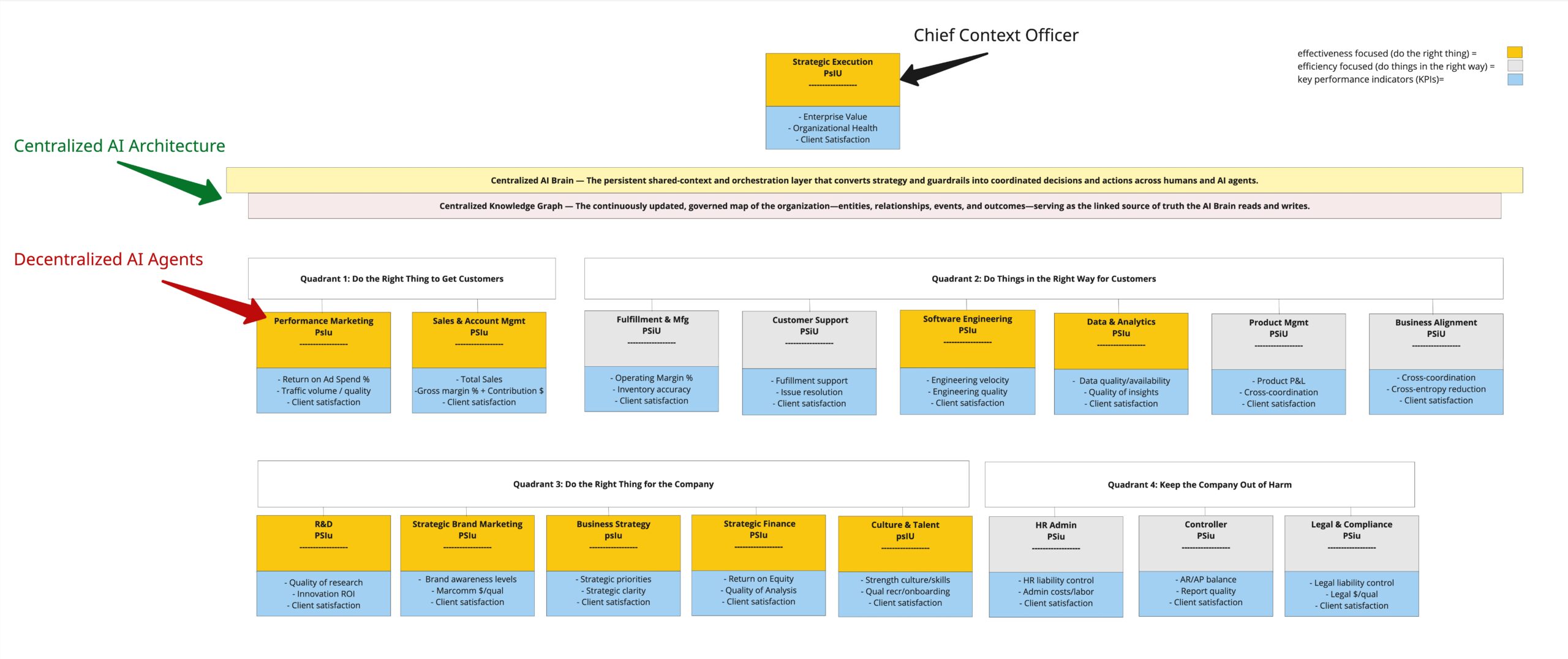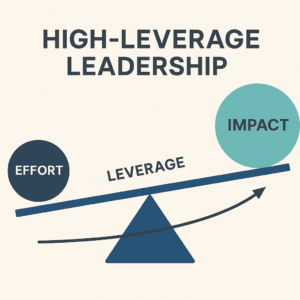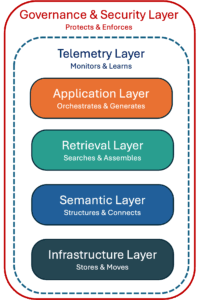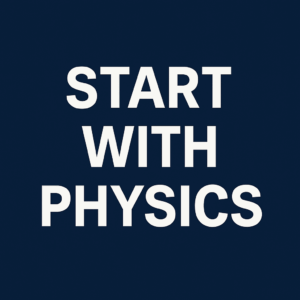Summary Insight:
Every tech wave reshapes how we organize. AI won’t just add tools—it will rewire strategy, structure, process, and people. The question is: will your company adapt its design or get left behind?
Key Takeaways:
- Structure: AI demands a centralized brain and knowledge graph as the core.
- Strategy: Long-range planning still matters—don’t let short-term AI iterations dominate.
- Process: Silos aren’t solved by technology; they’re solved by design plus AI integration.
- People: The winners will be augmented humans, not replaced ones.
This article was originally published on Lex Sisney’s Enterprise AI Strategies Substack.
Every major technology wave doesn’t just change the tools we use.
It rewires how we organize ourselves.
Take three big societal leaps:
- From Hunter-Gatherers to Agrarian Societies
When fire, tools, and farming knowledge spread, people stopped roaming in small tribes. They built permanent villages, stored food, and created hierarchies to manage land and labor. Technology made it possible to coordinate at scale — and suddenly you had chiefs, councils, and organized religion to hold it all together.
- From Agrarian to the Industrial Revolution
Steam engines, mechanized farming, and electricity broke the limits of human and animal muscle. Families left small farms for urban factories. The “company” as we know it emerged — structured shifts, middle management, and a clock-in, clock-out mentality. Technology forced society to invent entirely new ways of organizing work.
- From the Industrial Age to the Information Revolution
Computers, the internet, and mobile networks took the factory model and blew it apart. No more walls, no more fixed hours. Work could flow across borders and time zones. Companies evolved into global networks — flatter, faster, and more specialized. Once again, technology reshaped how humans collaborate, decide, and scale.
- Now, AI is here.
Just like farming, steam, and silicon before it, AI is already reshaping what’s possible. But the question is: What new forms of organization will this wave create?
That’s the question that I’m going to answer in this article. I’m going to do it in such a way that you’ll have a roadmap to follow as your company adopts its own enterprise AI strategy.
What Do I Mean by Structure?
Organizational structure is a loaded topic. There are endless terms, competing definitions, and plenty of strong opinions. But from a systems view, here’s what really matters:
Structure is how a system is organized.
In a business, structure defines:
- The functions it must perform (sales, engineering, marketing, etc.).
- The location of each function in the hierarchy (yes, there is a hierarchy — which is why your brain is in your head and not in your ass).
- The authority each function has to make decisions and get work done.
Process is how the organization performs those functions together.
Just as your brain sends and receives signals to the rest of the body, your company has processes that transmit information across functions. Those processes may be highly optimized or painfully inefficient — but they exist either way.
Strategy is how the organization pulls energy from its environment.
For a business, “energy” shows up as sales, customers, and market clout.
Structure—how the business is organized—must support the strategy. Processes must allow the organization to sense and respond as one system. If the strategy is wrong, or if structure and process fail to fit the environment, the company won’t last.
People bring the energy and capability.
They set and support the strategy, energize roles in the structure, and keep processes alive. If they don’t resonate around a shared culture, or if they lack the capability to meet the demands of this stage, the system will fail.
So here’s our working definition of the main components of organizational design: structure, process, strategy, and people. All of them integrate into either a high-functioning or low-functioning design.
Notice what I didn’t include as a primary component: incentives. Incentives are simply a process — one way of influencing how people get the work done.
I also didn’t include culture. Culture is the invisible force that creates unity — or disunity, in the case of a toxic culture — among the people involved. It’s a critical factor in organizational performance, but it sits outside the scope of this article.
What Organizational Changes Are Going to Occur with AI?
Using the definitions above, it becomes much easier to cut through the noise and make sense of the structural debate around AI. Right now, most of the conversation I see online is circling around questions like these:
- Strategy: Will we even need strategy documents , or will AI just keep iterating its way forward? And does “product” even matter when an AI can just ruthlessly duplicate what you worked so hard to create and defend?
- Structure: Will we still have distinct functions like sales and engineering, or will one AI effectively run them all?
- Process: Will the speed and capabilities of agentic AI finally dismantle the silos that have plagued organizations for decades?
- People: Will this era lead to massive job losses, massive job gains, or simply massive job changes — both near-term and long-term?
So let’s break these questions down — and then paint a picture of what you should be doing now in your organizational design choices to prepare for the coming enterprise AI wave.
And if you have questions I haven’t covered here, share them. If enough leaders are wrestling with the same issue, I’ll tackle it in a future piece.
AI Changes to Strategy
I was listening to a recent podcast with Asha Sharma, Microsoft’s President of CoreAI Product: “How 80,000 companies build with AI: Products as organisms and the death of org charts.”
At one point she asked a rhetorical question:
“Will we even have strategy docs going forward? I’m not so sure…”
She didn’t answer it directly, but the way she framed it was telling. Her point was that AI, with recursive learning, can essentially A/B test its way forward on every possible product decision. It can learn and replicate what’s working in competing products. So what’s the point of strategy, when your AI can just AlphaGo its way relentlessly through the market? And what’s the point of a “product plan” — or even a “product” — when AI can deliver a personalized experience to N+1 users?
That’s the nature behind her question.
So what’s the answer?
Unless you design against it, short-range iterations will dominate. They’ll be exceptional at incremental improvements within a domain. Those improvements may even look magical. But they won’t help your company discover opportunities across domains.
Your job — together with your AI thought partner — is to assess market opportunities and threats, assess internal strengths and weaknesses, and craft a strategy for the long range.
Remember the second rule of structure: “Do not allow short-range functions to control long-range ones.”
So yes — successful organizations will still do long-range strategic planning and positioning. And yes — because the CEO’s #1 job is to be the Chief Context Officer — that will still require writing it down as a digestible strategy doc.
Answer: Yes, we will still have strategies and strategy docs — to clarify, to communicate, and to keep the long view in focus.
AI Changes to Structure
A16Z’s Andrew Chen recently asked, “Does it still make sense to have separate functions like engineering, product, or design? Or will AI collapse them into one?”
The answer: of course there will still be separate functions. Engineering, product, design, finance, strategy, support—each has its own purpose.
The confusion comes from imagining one AI super-agent that can do everything. That’s not how systems work. Structure is how the system is organized. Even with zero employees, AI agents will specialize—sales AI, marketing AI, support AI—just like your brain and your heart are specialized organs.
It helps to picture a company designed around four quadrants:
- Quadrant 1 – Do the Right Thing to Get Customers (short-range/effective)
- Quadrant 2 – Do Things in the Right Way for Customers (short-range/efficient)
- Quadrant 3 – Do the Right Thing for the Company (long-range/effective)
- Quadrant 4 – Keep the Company Out of Harm (long-range efficient)
Every resilient structure needs all four. A smart leader designs around these quadrants so the system thrives now and over time.
What’s missing from most enterprise AI discussions is the acknowledgment that a centralized AI brain and knowledge graph must anchor the organization. This architecture provides shared context across the organization. With it, decentralized AI agents can act as true functional thought partners, and even semi-autonomous workers.
Picture it: every company’s structure is unique, but the AI-empowered structure always rests on the same foundation—specialized functions connected through a centralized AI brain and knowledge graph across quadrants.

Answer: Yes, we will still have organizational functions.
Enterprise AI Case Study
To bring this structural approach to life, consider a mid-sized commercial real estate firm that re-architected around a centralized AI brain and knowledge graph. Before adoption, they’d hit a ceiling. Proprietary market and asset data were trapped in spreadsheets and departmental silos. Deal sourcing, leasing, and property management all operated without a unifying decision layer. Teams spent more time reconciling OKRs, proposals, and workflows than actually moving deals forward. Traditional tools couldn’t keep up.
They rebuilt the core of the business on Fostr AI (FostrAI.com) as the operating system. A centralized AI brain unified every proprietary data stream into a living knowledge graph. Core processes—from investment committees to leasing approvals—became AI-augmented, context-rich, and radically faster. Tools like GIS overlays, once isolated, plugged directly into the brain. What used to take weeks now took minutes. Employees shifted from data wrangling to decision-making. From firefighting to focused execution.
The results? Revenue per employee up more than 180%. Deal velocity way up. Cross-functional workflows turned into a disciplined rhythm. The big unlock wasn’t smarter tools—it was smarter structure. AI didn’t sit on top of legacy systems. It became the connective tissue between people, process, and strategy. That’s what scale looks like.
👉 The lesson: enterprise AI isn’t bolting tools onto old systems. It’s re-architecting the business around a centralized brain and knowledge graph — turning AI into the structural core of how the organization executes.
➡️ Is your current structure fit to host distributed intelligence? Find out by reading my book Designed to Scale: How to Structure Your Business for Exponential Growth or by watching this free video course: https://organizationalphysics.com/structure-change-videos/
AI Changes to Process
From my vantage point, this is where AI innovation thrives today. Think about how much more productive you are by using AI tools today than just twenty-four months ago. In knowledge work, the floor is at least 30% more productive. The ceiling feels closer to 70%. This will only increase. Imagine an economy where every knowledge worker is 30–70% more productive—then add the robotics revolution. We’re entering a decades-long trend of lower costs and higher productivity.
But will AI dismantle organizational silos? Let’s be clear: if you’re already allowing silos and disparate data sources to harm your operations, you’re doing it wrong even without AI. Silos aren’t a feature of org design. They’re a bug—evidence of a breakdown in strategy, structure, process, or leadership.
Enterprise AI is only as good as its centralized data layer. If that layer exists and is robust, then yes—AI will help bust down silos that shouldn’t be there in the first place. But if you just bolt AI onto a flawed or siloed organization, it won’t help much. You’ll still need to redesign the org, its culture, and its leadership to embrace AI and transparency.
Answer: Yes, AI will help eliminate silos—but only the ones that shouldn’t exist anyway. It’s not a cure-all for a siloed, change-resistant organization.
AI Changes to People
The current debate is whether AI agents—software capable of acting without human oversight—will replace workers en masse, simply augment them, or land somewhere in between. To me, that’s the wrong debate.
Here’s what’s real: today’s wave of AI agents is already colliding with the trough of disillusionment. Early adopters discover that agents create as much noise, chaos, and error correction as value. It’s often faster to write deterministic code—or assign a human—than to clean up after a runaway agent. Will the vision of a solo entrepreneur building a billion-dollar business with nothing but AI agents come true? Someday, yes. But the tech is still raw, with a steep learning curve.
The real change isn’t in replacing people—it’s in augmenting them. Every human is now an augmented human, with AI super-intelligence at their fingertips. Those who adopt it as a thought and production partner will be 10X (100X? 1000X?) more productive than those who don’t. That’s where the real leverage lies.
Management will also change radically. Whether leading people, agents, or both, managers are now prompt engineers. Their value lies in mastering a domain—marketing, sales, engineering—and crafting prompts that elevate system performance. These augmented humans will hold and apply leverage across massive workstreams at scale.
If you’re a CEO, the real question is: what talent do you need in each function who can both master their domain and excel at prompt engineering—while adding energy, resiliency, and context across the entire organization?
Answer: AI is transforming how people work. The bigger societal changes are still to come.
Summary
Every technology wave in history has forced us to rewire how we organize ourselves. AI will be no different. But the change won’t come from shiny tools or runaway agents. It will come from how leaders redesign strategy, structure, process, and people to align with an AI-powered foundation.
The winners will be those who use AI to expand long-range vision, anchor their organizations with a centralized brain and knowledge graph, eliminate silos at the root, and elevate people into augmented super-performers. The losers will be those who bolt AI onto broken systems and expect miracles.
AI is not just another tool. It is the next organizing force of human work.
📌 P.S. Jason Baxter, co-founder & CEO of FostrAI.com, and I are launching a new Slack channel for CEOs who get it—leaders committed to transforming their organizations with true enterprise AI. DM me for an invite.




